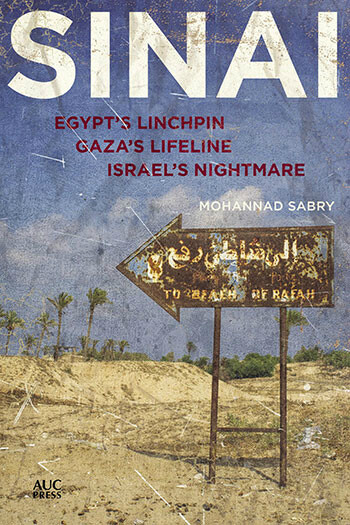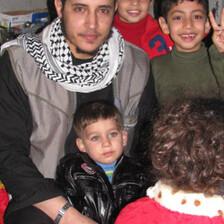The Electronic Intifada 11 February 2016

Sinai: Egypt’s linchpin, Gaza’s lifeline, Israel’s nightmare by Mohannad Sabry, American University of Cairo Press (2015)
From a Palestinian affairs perspective, Egypt is usually mentioned in relation to its Rafah border with southern Gaza, or occasionally with regard to the policies of the Cairo government and its peace agreement and cooperation with Israel.
But what about the Sinai, that huge, little-known and poorly understood region that stretches from southern Gaza and present-day Israel to the Suez Canal?
Heavily militarized by Egypt and portrayed in the West as a stronghold of Islamist militant supporters of the Islamic State group and al-Qaida, how do social, political and security trends there interact with those of Gaza’s Hamas government and the Israeli state?
Mohannad Sabry, an Egyptian journalist who has reported from Sinai for many years, is well-placed to address such questions. His highly readable book is based not only on an impressive range of secondary sources, but also interviews with Bedouin leaders, Egyptian army officers, human rights activists, local journalists and ordinary people living, working and trying to survive in the Sinai.
The picture that Sabry presents, based on his observations, experiences, interviews and research, is one horrifyingly familiar to anyone who follows the way Palestinians in the occupied West Bank and Gaza Strip are routinely treated by the Israeli army.
A familiar story
Harassment, house demolitions, civilians killed at checkpoints, villages encircled with barbed wire, arbitrary arrests, torture and imprisonment — these are parts of a familiar story, except they are happening on the other side of the border. And these policies are perpetrated by the Egyptian military against Sinai’s inhabitants.
Sabry’s sympathies are very much with the ordinary people — whether Bedouin or of Palestinian or other origin — who exist under the capricious and often brutal rule of the Egyptian army. His account weaves its way through high-level politics — including the demises of Egyptian presidents Hosni Mubarak and Muhammad Morsi, as well as Abdulfattah al-Sisi’s coup — but he always comes back to the impacts they have on average citizens.
This multi-leveled approach allows him to talk about the rise and fall of politicians and the machinations of global Islamist groups alongside the fate of a small child shot dead by Egyptian soldiers at a checkpoint.
In between, Sabry draws in the complexities of life in Sinai. He discusses the tunnels which pass under the border into Gaza, going beyond the stereotypes of gun-running to acknowledge their vital role in the Sinai and Gaza economies. He charts their development over two decades from small, low-tech constructions to major operations fed by double-level car transporters.
He also unpacks the way in which the Hamas authorities in Gaza have tried to deal with extreme Islamists — sympathizers with the likes of al-Qaida and Islamic State. Sabry describes how Hamas has tried to clamp down on these groups, sometimes sparking deadly sieges and outbreaks of violence.
Gas and outrage
But — attempting to use the tunnels as a “safety valve” for the situation within Gaza — Hamas has also allowed and perhaps even encouraged these groups to break out into the Sinai, spurring more unrest there. Sabry suggests that Hamas would rather local militants operated from the Sinai so that Israeli reprisals don’t hit the already devastated infrastructure of Gaza.
He cites the plausible claim that, because of attacks from Israel’s army on its security forces in the section of the Rafah border closer to the Israeli boundaries, Hamas cannot maintain control of the tunnels in that sector. Islamist militants exploit this, Hamas claims, to pass into Gaza to foment unrest, and out into Sinai where they can contact international jihadists.
In Sinai, Sabry recounts, Palestine itself is both a powerful symbol and a call to arms, with some jihadist groups riven by disputes over whether to confront Israel or other targets.
A major source of discontent among Bedouin communities has been the gas infrastructure that carries Egyptian fuel across Sinai and into Israel. The pipeline has repeatedly been targeted by militants and Bedouins — and public opinion throughout Egypt was enraged by the opaque deal with Israel, which saw Egyptian gas sold at a far lower price than ordinary people were paying for their domestic supply.
Popular fury at this political corruption and the hardship it brought for people unable to cook or heat their homes was combined with anger at the sale of Egypt’s national resources to a country which perpetrated abuses in Palestine, prevented Muslim access to the sacred sites of Jerusalem and had occupied the Sinai itself.
Disturbing portrait
The Egyptian government added insult to injury by ignoring the fact that many of the Sinai’s Bedouin risked their lives to fight the Israeli army during its occupation of the peninsula after the 1967 War.
Once the Egyptian government had signed the notorious Camp David accords with Israel and the military regained control of Sinai, the Bedouins’ skills in tracking, espionage and guerrilla warfare became the object of suspicion rather than celebration.
Overall, this is an engaging, informative book which delivers a disturbing portrait of a region largely forgotten except when tourists are hit by terrorist attacks but which bears the brunt of the Egyptian government’s brutal repression and its collaboration with the State of Israel.
Sabry’s journalistic style is readable and accessible, although sometimes verging on sensationalist — many militants and other interviewees are “broad-shouldered” and “bearded.” Sabry speaks to one such informant with “his AK-47 sitting beside him in the car.”
The book might also have been improved by including more background information. As a little-known region, many readers may struggle — especially at the beginning — with the journalistic plunge into events, with much of the context coming later.
Finally, although Sabry seems driven by a desire to let the ordinary people of Sinai find their voice, his is a very gendered image of Egyptian state repression. It may be men who are most prominent in the state, army, militant groups and among smugglers.
But it is well-established that women are hugely affected by the kind of low-intensity warfare shown in the book. How do endemic violence, restrictions on movement and the entrenchment of conservative values impact on Sinai’s women?
Sarah Irving is author of a biography of Leila Khaled and of the Bradt Guide to Palestine and co-editor of A Bird is not a Stone.





